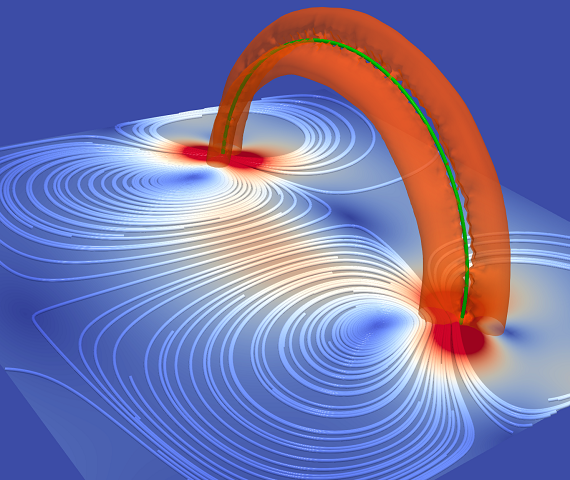Research News
Jun 1, 2023
- Science
Finally solved! The great mystery of quantized vortex motion
Explaining the interaction between quantized vortices and normal fluids
The interaction between quantized vortices and normal fluids explained
Visualization of quantized vortex ring above the plane (green curve), normal-fluid vortex rings (reddish half circles)

Liquid helium-4, which is in a superfluid state at cryogenic temperatures close to absolute zero (-273°C), has a special vortex called a quantized vortex that originates from quantum mechanical effects. When the temperature is relatively high, the normal fluid exists simultaneously in the superfluid helium, and when the quantized vortex is in motion, mutual friction occurs between it and the normal-fluid. However, it is difficult to explain precisely how a quantized vortex interacts with a normal-fluid in motion. Although several theoretical models have been proposed, it has not been clear which model is correct.
A research group led by Professor Makoto Tsubota and Specially Appointed Assistant Professor Satoshi Yui, from the Graduate School of Science and the Nambu Yoichiro Institute of Theoretical and Experimental Physics, Osaka Metropolitan University respectively in cooperation with their colleagues from Florida State University and Keio University, investigated numerically the interaction between a quantized vortex and a normal-fluid. Based on the experimental results, researchers decided on the most consistent of several theoretical models. They found that a model that accounts for changes in the normal-fluid and incorporates more theoretically accurate mutual friction is the most compatible with the experimental results.
“The subject of this study, the interaction between a quantized vortex and a normal-fluid, has been a great mystery since I began my research in this field 40 years ago,” stated Professor Tsubota. “Computational advances have made it possible to handle this problem, and the brilliant visualization experiment by our collaborators at Florida State University has led to a breakthrough. As is often the case in science, subsequent developments in technology have made it possible to elucidate, and this study is a good example of this.”
Their findings were published in Nature Communications.
Funding
JSPS KAKENHI program under Grant No. JP22H01403
Paper Information
Journal: Nature Communications
Title: Imaging quantized vortex rings in superfluid helium to evaluate quantum dissipation
DOI: 10.1038/s41467-023-38787-w
Author: Yuan Tang, Wei Guo, Hiromichi Kobayashi, Satoshi Yui, Makoto Tsubota and Toshiaki Kanai
Publish: 23 May 2023
https://doi.org/10.1038/s41467-023-38787-w
Contact
Graduate School of Science
Makoto TSUBOTA
E-mail: tsubota [at]omu.ac.jp
*Please change [at] to @.
SDGs
